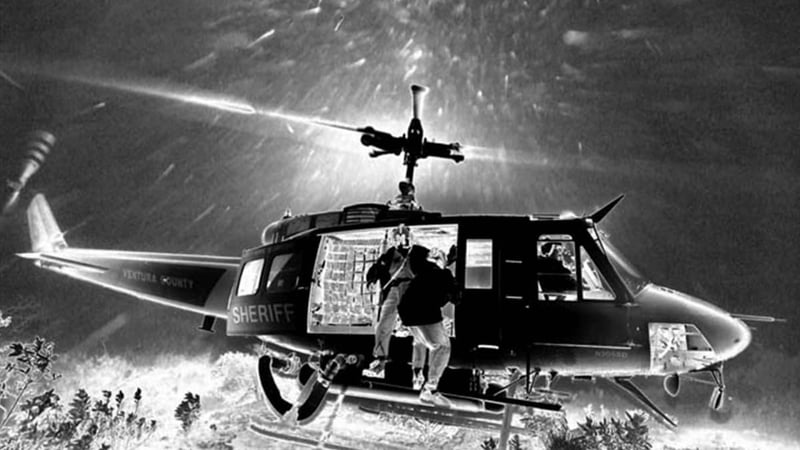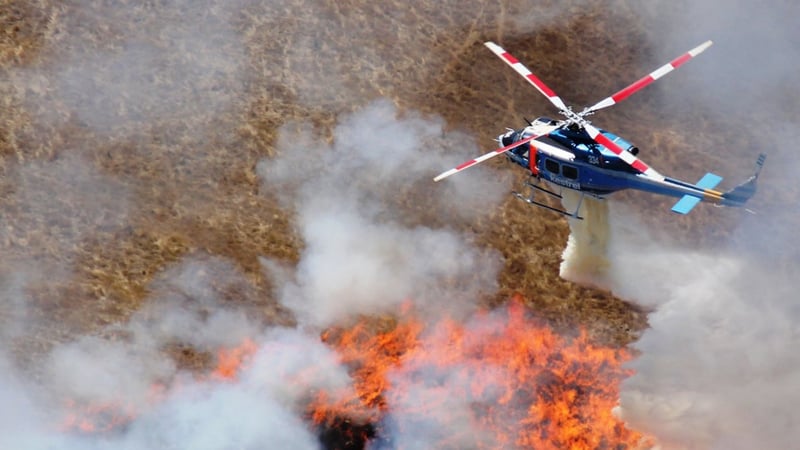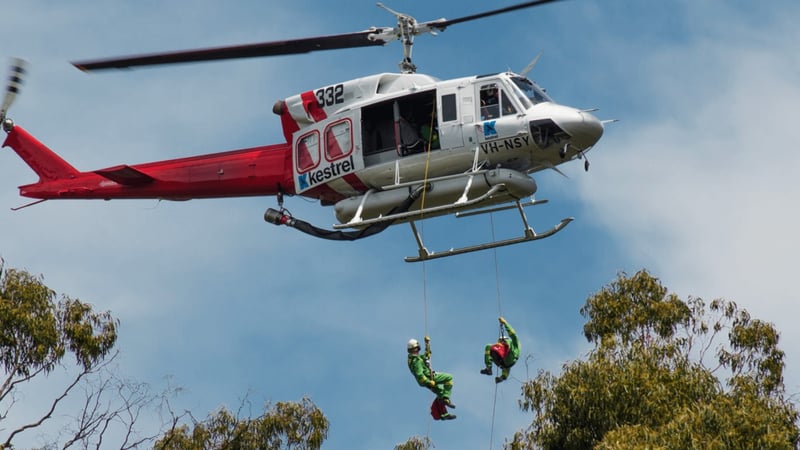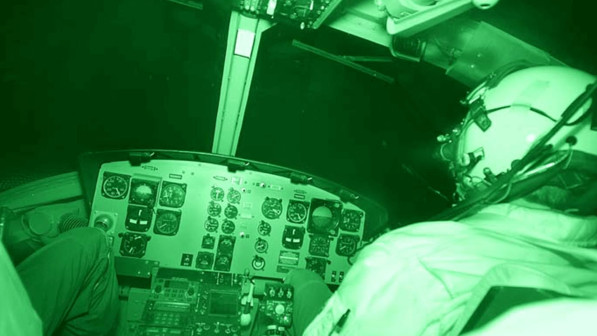- Ventura County Aviation Unit
- Kestrel Aviation
Ventura County Aviation Unit
Ken Williams, Senior Pilot with Ventura County Aviation Unit (VCAU), an organization that combines Ventura County Fire Department and Ventura County Sheriff’s Department aviation assets, has been using NVG for 16 years. In addition to firefighting, VCAU provide services such as Search & Rescue, Medical Evacuation, and Law Enforcement across Ventura County.
VCAU started flying with NVG in 1995 and fought one of the largest wildfires in California history last fall, the 281,893-acre Thomas Fire. Ken provided some insight on what he’s learned as not only a user of NVG, but as an Intermediate Level Goggle Maintenance Technician/Maintainer at VCAU.
“Goggles allow a pilot to safely survey an area during the initial attack phases of a wildfire to identify hazards and obstructions that otherwise cannot be seen during daylight operations,” he stated.
“Airborne embers that are carried away from the main fire that create spotting can also be seen.”

NVG allows fire pilots to help with the evacuation of civilians ahead of the fire, clearing people from property before the fire front arrives. “They also provide critical updated information to the incident commander on the forward progression of the fire,” he added. “as well as continued engagement in firefighting operations when weather and environmental conditions are reduced.”
But flying at night is not without its hazards.
“NVG has a limited field of view - only 40° - and can suffer from ‘blooming’ caused by additional light sources other than ambient lighting,” Ken pointed out.
“There is also the problem of multi-tasking operations above and beyond flying the aircraft.”
As others have noted, utility lines and wires strung across areas around the fire can pose a hazard, as can the potential for the goggles to fail during critical phases of a flight, all stressful situations for a firefighting pilot.
Ken pointed out that flying at night isn’t cheap, either.
“On average, it costs between $50,000 and $95,000 to retrofit a helicopter to use NVG, depending on the size of the aircraft.”
Training is also a consideration, with a firefighting pilot requiring 20 hours of initial training during their transition into night flying.
Despite the cost and other difficulties in creating and maintaining an NVG-equipped force, Ken believes it’s worth it and recommends NVG to other fire agencies, both in Southern California and elsewhere.
Kestrel Aviation
Aerial fire suppression has been conducted for over fifty years in Australia with a proud safety-conscious history of innovation. These themes have continued with the recent night firebombing trials in Victoria which have resulted in Kestrel Aviation obtaining CASA approval to conduct helicopter firebombing by night. Ray Cronin, the Managing Director of Kestrel Aviation, provided some insight on how they have achieved this coveted goal and what the future may hold for fire agencies battling bushfires across the continent.
“Aerial fire suppression by night is not new, having been conducted in North America with significant success,” Ray explained.
“Night fire suppression combines proven helicopter firebombing resources with night vision technology to enable the safe operation of aircraft at night.”
But this isn’t the first time NVG has been used Down Under. “Whilst the recent trials were a first for Australia, the use of night vision to augment aviation is not. Night vision has been used in the Australian Defence Force for many years, safely transitioning to the civil sector for Air Ambulance, Law Enforcement and SAR (Search and Rescue).”
And a number of folks saw the need to emulate their brethren in North America. “Both the National Aerial Firefighting Centre (NAFC) and Emergency Management Victoria (EMV) have demonstrated a willingness to develop a night firebombing capability in addition to current night observation and incendiary approvals,” Ray explained.
“The challenge was the lack of precedent for such operations in Australia and, as such, different approaches were undertaken, culminating with a cooperative trial.”
The trials, which began in late 2017 and stretched into early 2018, put various aircraft through their paces, resulting in satisfaction by all parties involved that NVG offered a substantial advantage in attacking bushfires at night, when winds died down and humidity increased to a point that drops which might otherwise be ineffective in windy daytime conditions, now became more effective.
“In accordance with a temporary management instruction released by CASA, Kestrel formulated a phased development program based on a crawl, walk, run methodology and a flight crew combination integrating both day firebombing experience and night vision operation,” Ray continued.
“The concept was to transition established industry procedures to the fire ground via a series of controlled proving flights, designed to incrementally increase environmental complexity and culminating with an operational test and evaluation (OT&E) coordinated by the fire agencies.”

The first phase for Kestrel was to obtain the approval to drop the water from a belly tank at night in various levels of terrestrial luminosity. The first flight was in January 2018, with subsequent approval for an OT&E being granted from CASA in March 2018.
“Kestrel’s OT&E integrated with live fire trials that were driven by EMV’s desire to have a future aerial night bombing capability,” said Ray.
“The trials were coordinated by EMV, with significant contributions from the Country Fire Authority, Department of Environment, Lands and Water Planning, and the CASA. The trials proved very successful and paved the way for Kestrel to obtain its unrestricted night firebombing approval in March 2018.”
With what is shaping up to be a daunting bushfire season in the 2018-2019 period, fire agencies across Australia are bracing for the worst, and being able to fight bushfires under more favourable conditions at night may give Victoria an edge over other fire agencies.

“The expectation this season was to obtain the relevant approvals, prove the concept and demonstrate the safe and effective delivery of water to the fire ground. The next challenge is focused on the real-world application of capability in terms of the interaction between fire agencies and approved operators, developing a set of work practices that will maintain a safe and coordinated outcome for all stakeholders.”
This effort has been one of the most significant developments for the professional aerial firefighting arena in Australia for many years, and is a credit to all involved, from the Emergency Service Sectors, and the Aviation Regulator to the operators themselves.
Ray is encouraged by what he sees.
“Having contributed to the early stages of this new capability it will be interesting to watch the skills and use of night firebombing develop over the coming years.”
Victoria has taken its first steps in this new direction. Other states, like New South Wales, are already beginning to experiment with NVG and will undoubtedly follow in the years to come as bushfires worsen Down Under.
Night Vision Goggles Bringing Wildfires Into Focus - Part 1
Night Vision Goggles Bringing Wildfires Into Focus - Part 2
Night Vision Goggles Bringing Wildfires Into Focus - Part 3
